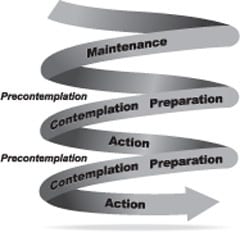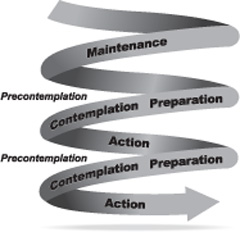Successful change comes only in stages. How long it takes is an individual matter.
You may be well on your way to making some of the changes you resolved to make back in January. If so, that’s great. If not, you may understandably be feeling discouraged. New Year’s resolutions are notoriously hard to keep, especially when they’re aimed at health behaviors such as losing weight, eating better, and exercising more. In fact, no matter when we decide to make a change — or how strongly we’re motivated — adopting a new, healthy habit, or breaking an old, bad one, can be terribly difficult. But research suggests that any effort you make is worthwhile, even if you encounter setbacks or find yourself backsliding from time to time. Just making a New Year’s resolution, for example, may boost your chances of eventual success.
When it comes to health recommendations, we mostly know the drill: exercise most days, eat a varied and nutritious diet, keep body mass index in the normal range (18.5 to 24.9), get enough sleep (seven to eight hours a night), don’t smoke, and limit alcohol to one drink a day. What we do for ourselves in these areas is often more important than what medicine can offer us. Adopting a healthier lifestyle can affect not only your risk for disease and the way you feel today but also your health and ability to function independently in later life. (See “The impact of lifestyle factors on independent living.”)
The impact of lifestyle factors on independent livingIn a 20-year study that followed nearly 6,500 middle-aged and elderly people, those who smoked, were obese or physically inactive, or had diabetes or uncontrolled high blood pressure when the study began were much more likely to require admission to a nursing home later on. Middle-age smoking increased the chance of a nursing home admission by 56%, physical inactivity by 40%, and uncontrolled high blood pressure by 35%. Diabetes more than tripled the risk. Middle-age obesity was also associated with higher risk, but the association wasn’t statistically significant — that is, the numbers could have resulted from chance. All of these conditions can, of course, be modified with lifestyle changes. Even after a setback such as a stroke, lifestyle can make a difference. A study in the Journal of Neurology, Neuroscience, and Psychiatry (February 2012), which involved more than 15,000 American adults with a history of stroke, found that regular exercise and not smoking were each associated with a reduced risk of dying from any cause. Moreover, the more healthy behaviors that participants embraced (for example, eating five or more daily servings of fruits and vegetables in addition to exercising and not smoking), the lower their death rate for all causes. |
What helps?
Considerable research has sought to identify factors that contribute to successful behavior change and to develop more effective tools for clinicians to encourage their patients to adopt healthier habits, especially in the context of a brief office visit. One potential roadblock: too often we’re motivated by negatives such as guilt, fear, or regret. Experts agree that long-lasting change is most likely when it’s self-motivated and rooted in positive thinking. For example, in an analysis of 129 studies of behavior change strategies, a British research group found that the least effective approaches were those that encouraged a sense of fear or regret. Studies have also shown that goals are easier to reach if they’re specific (“I’ll walk for 30 minutes every day,” rather than “I’ll get more exercise”). You should also limit the number of goals you’re trying to reach; otherwise, you may overtax your attention and willpower. And it’s not enough just to have a goal; you need to have practical ways of reaching it. For example, if you are trying to quit smoking, have a plan for quelling the urge to smoke (for example, keep a bottle of water nearby, chew sugarless gum, or practice deep breathing).
Change is a process, not an event
Research has produced several models that help account for success and failure and explain why making healthy changes can take so long. The one most widely applied and tested in health settings is the transtheoretical model (TTM). Developed in the 1980s by alcoholism researchers James O. Prochaska and Carlo C. DiClemente, TTM presupposes that at any given time, a person is in one of five stages of change: precontemplation, contemplation, preparation, action, or maintenance.
The idea is that each stage is a preparation for the following one, so you mustn’t hurry through or skip stages. Also, different approaches and strategies (called “processes of change” in the TTM model) are needed at different stages. For example, a smoker who’s at the precontemplation stage — that is, not even thinking about quitting — probably isn’t ready to make a list of alternatives to smoking.
Most of the evidence for this model comes from studies of alcohol use, drug abuse, and smoking cessation, but it’s also been applied to other health-related behaviors, including exercise and dieting. Clinicians and health educators use TTM to counsel patients, but you don’t need to be an expert; anyone motivated to change can use this model. Here is a description of the stages of change and some ideas about how people move through them:
Precontemplation. At this stage, you have no conscious intention of making a change, whether it’s because you lack awareness or information (“Overweight in my family is genetic; it’s just the way we are”) or because you’ve failed in the past and feel demoralized (“I’ve tried so many times to lose weight; it’s hopeless”). People in this stage tend to avoid reading, talking, or thinking about the unhealthy behavior, but their awareness and interest may be sparked by outside influences, such as public information campaigns, stories in the media, illnesses, or concern from a clinician, friend, or family member. To move past precontemplation, you need to sense that the unhealthy behavior is blocking your access to important personal goals, such as being healthy enough to travel or enjoy children or grandchildren.
Contemplation. In some programs and studies that employ TTM, people who say they’re considering a change in the next six months are classified as contemplators. In reality, people often vacillate for much longer than that. At this stage, you’re aware that the behavior is a problem, but you still haven’t made a commitment to take action. Ambivalence may lead you to weigh and re-weigh the benefits and costs: “If I stop smoking, I’ll lose that hacking cough, but I know I’ll gain weight,” or “I know smoking could give me lung cancer, but it helps me relax; if I quit, the stress could kill me, too!”
Health educators have several ways of helping people move on to the next stage. One strategy is to make a list of the pros and cons, then examine the barriers (the cons) and think about how to overcome them. For example, many women find it difficult to get regular exercise because it’s inconvenient or they have too little time. If finding a 30-minute block of time to exercise is a barrier, how about two 15-minute sessions? Could someone else cook dinner so you can take a walk after work? If you feel too self-conscious to take an exercise class, what about using an exercise video at home?
Preparation. At this stage, you know you must change, believe you can, and are making plans to do so soon. You’ve taken some initial steps — perhaps joined a health club, bought a supply of nicotine patches, or added a calorie-counting book to the kitchen shelf. At this stage, it’s important to anticipate obstacles. If you’re preparing to cut down on alcohol, for example, be aware of situations that provoke unhealthy drinking, and plan ways around them. If work stress triggers end-of-day drinking, plan to take a walk when you get home. If preparing dinner makes you want a drink, plan to have seltzer water instead of wine.
Meanwhile, create an action plan with realistic goals. If you’ve been sedentary and want to exercise more, you might start with a goal of avoiding the elevator for two-, three-, or four-floor trips. Or plan to walk 15 minutes every day. Then you can work your way up to more ambitious goals.
Action. At this stage, you’ve changed — stopped smoking, for example (according to Prochaska, merely cutting down would not be “action” but preparation for action) — and you’ve begun to face the challenges of life without the old behavior. You’ll need to practice the alternatives you identified during the preparation stage. For example, if stress tempts you to eat, you can use healthy coping strategies such as yoga, deep breathing, or exercise. At this stage, it’s important to be clear about your motivation; if necessary, write down your reasons for making the change and read them every day. Engage in positive “self-talk” to bolster your resolve. Get support. Let others who care about you know that you’re making a change.
Maintenance. Once you’ve practiced the new behavior for six months, you’re in the maintenance stage. Now your focus shifts to integrating the change into your life and preventing relapse. That may require other changes, especially avoiding situations or triggers associated with the old habit. It can be tough, especially if it means steering clear of certain activities or friends.
Spiral model of the stages of changeResearch has shown that you will rarely progress through the stages of change in a straightforward, linear way. Relapse and recycling are common, though you usually don’t go back to square one. The spiral model suggests that relapses provide opportunities to learn what didn’t work and make different plans for the next “round.” CLICK HERE FOR ARTICLE SITE Source: Adapted from Prochaska JO, et al. “In Search of How People Change,” American Psychologist (Sept. 1992), Vol. 27, No. 9, pp. 1102–14. |
It can take a few rounds
The path between stages is rarely straightforward. Most people relapse at some point and recycle through one or more stages (see the illustration, “Spiral model of the stages of change”). For example, if you relapse during the maintenance stage, you may find yourself back at the contemplation or preparation stage. One study found that smokers cycled through the “action” stage three or four times, on average, before they succeeded in quitting.
Relapse is common, perhaps even inevitable. You should regard it as an integral part of the process. Think of it this way: you learn something about yourself each time you relapse. Maybe the strategy you adopted didn’t fit into your life or suit your priorities. Next time, you can use what you learned, make adjustments, and be a little ahead of the game as you continue on the path to change.



